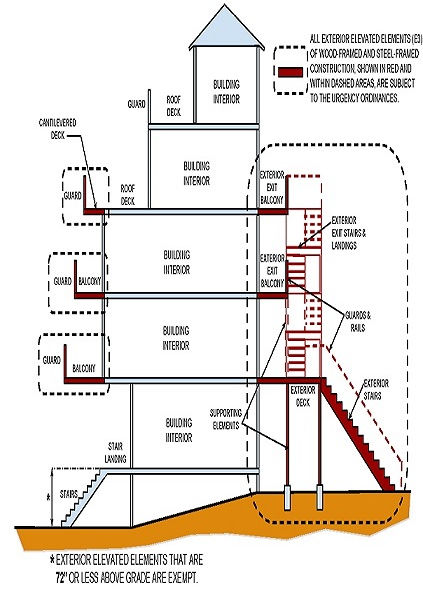
Bertech
LLC
SB 326 and SB 721: Balcony Inspection Laws in California
The California State Legislature passed two laws in 2019 and 2021 that require all common interest developments (CIDs) in California to have their balconies inspected by a licensed structural engineer or architect. These laws are designed to improve safety and prevent balcony collapses.
-
SB 326
SB 326, which went into effect on January 1, 2020, requires all balconies, decks, walkways, stairs, and railings that are 6 feet or more above ground level in CIDs to be inspected visually by a licensed structural engineer or architect. The inspection must be completed no later than six years after the building's certificate of occupancy is issued. If the building was constructed before January 1, 2020, the inspection must be completed no later than six years after January 1, 2020.
-
Responsibilities
The responsibility for the inspection falls on the CID's homeowners association (HOA). The HOA must hire a licensed structural engineer or architect to conduct the inspection.
-
Consequences
If the inspection finds any problems, the HOA must take steps to repair them. If the HOA does not take steps to repair the problem, residents may file a lawsuit against the HOA.
-
SB 721
SB 721, which went into effect on January 1, 2022, expands the requirements of SB 326. The law requires balcony inspections to be conducted every three years, rather than six. Additionally, the law requires inspections to be conducted by a licensed structural engineer or architect who is registered with the state of California.
-
Additional requirements
-
The inspection must be conducted by a licensed structural engineer or architect who is registered with the state of California, or general Contractor holding any or all A, B, or C-5 licenses issued by the contractors state license board.
-
Inspections must be conducted every three years, rather than six.
-
Additional responsibilities
-
CIDs must provide residents with a written report of the balcony inspection.
-
-
Additional consequences
-
If the inspection finds any problems, the HOA must take steps to repair them within 30 days.
-
If the HOA does not take steps to repair the problem within 30 days, residents may file a lawsuit against the HOA.
-
SB 326 and SB 721 are designed to ensure the safety of balconies in CIDs in California. The laws require that all balconies be visually inspected by a licensed structural engineer or architect on a regular basis.
-
Additional details
Balcony inspections should look for signs of deterioration, corrosion, cracking, or other structural problems that could lead to a balcony collapse. The following elements should be inspected during a balcony inspection in California:
-
The balcony structure, including beams, columns, and supports.
-
The balcony railing, including railings, handrails, and anchors.
-
The balcony floor, including tiles, slate, or wood.
-
The balcony anchors, which connect the balcony to the building structure.
The inspection should be conducted in good weather conditions, and the inspector should have access to all areas of the balcony. The inspector should perform the inspection carefully and thoroughly, and should document all findings in an inspection report.
Balcony inspection reports should be provided to residents by CIDs. The reports should include a description of any problems found and the inspector's recommendations for repair.
CIDs that fail to comply with the requirements of SB 326 and SB 721 may be fined by the state of California.
Our inspections are comprehensive and meet all the requirements of SB 326 and SB 721. We look for signs of deterioration, corrosion, cracking, or other structural problems that could lead to a balcony collapse.
If our inspection finds any problems, we will provide you with a detailed report with our recommendations for repair.
To schedule a balcony inspection, contact us today. We are available to answer your questions and help you ensure the safety of your home.




